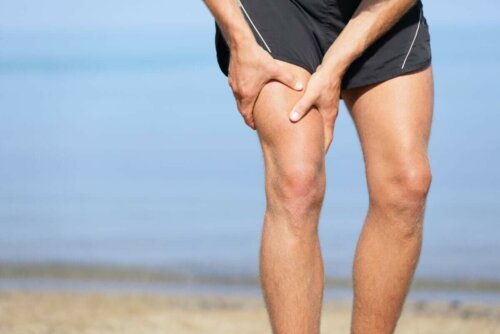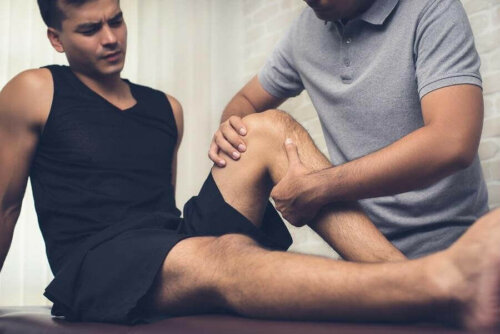Groin Strain: Why Does it Occur?


Written and verified by the biologist Samuel Antonio Sánchez Amador
Groin strain is a partial tear of the small fibers of the inner thigh adductor muscles. It can be mild or severe. With rest and proper treatment, patients usually make a full recovery.
This condition belongs to the group of groin problems. It occurs during recreational exercise-related activities, jobs that require a lot of physical effort, and accidents with vehicles, among many other situations. If you want to know more about groin strain and how it’s treated, keep reading!
How a groin strain occurs
As the Kidshealth website states, groin strain is when one of the muscles of the inner thigh gets stretched, injured, or torn. The muscles of the inner thigh are: the pectineus, adductor minimus, and adductor longus, which go from the pelvis to the femur, and the gracilis and adductor magnus, which go from the pelvis to the knee.
The Hopkinsallchildrens.org website explains the most common causes of this condition. Here are some of them:
- Sports that require sprinting, bursts of speed, or sudden changes in direction.
- Tight muscles. Muscles that haven’t been warmed up and stretched properly are more likely to tear.
- Poor conditioning or fatigue. Weak muscles are less able to handle the stress of exercise, and muscles that are tired lose some of their ability to absorb energy.
- Returning to activities too quickly after an injury.
Although this condition is usually related to the practice of exercise, this isn’t always the case. In general, any overly aggressive stretch of a muscle or a direct blow can lead to groin strain.

To know more, you should read: Hip Adductor Tendinopathy: What Is It and What Are Its Symptoms?
The symptoms of groin strain
The Rady Children’s website states that there are three degrees of groin strain. As you’ll see below, each of them causes different symptoms:
- Grade one. Mild pain that may not be noticeable until after you finish exercising, followed by tightness and tenderness.
- Grade two. Moderate pain and tightness in the groin, along with some minor swelling and bruising. Walking may be affected and running can be difficult.
- Grade three. Severe pain, considerable swelling and bruising, and an inability to squeeze the legs together. Walking will be very difficult.
Here are the most common symptoms of groin strain: swelling and bruising in the groin area, muscle spasms, weakness in the affected leg, and certain difficulty walking.
Diagnosis
Firstly, your doctor will ask you what you were doing before you felt the pain that led you to consult them. In general, the diagnosis is differential. In other words, the doctor examines the patient to rule out other conditions such as a sports hernia.
If the groin strain is grade one, less than 10% of the muscle fibers are torn. Grade two strains are those where 10% to 90% of the fibers are torn. Grade three means that the muscle is either completely or almost completely torn or ruptured. Sometimes, a doctor may request an MRI to quantify the extent of the tear.
Treatment of groin strain
The treatment will depend on the grade of injury. Milder cases can heal with a two-week rest, while a complete tear may require up to three months of recovery. Medical records indicate some of the guidelines that patients must follow to recover quickly:
- Rest. Don’t do any activity that causes pain during the recovery process.
- Cold. Applying ice with a cold compress on the groin area for 15 minutes about four times a day is a good way to relieve pain and swelling. Remember that you should never apply ice directly to the skin.
- Medication. Some over-the-counter drugs can help manage mild to moderate pain, such as non-steroidal anti-inflammatory drugs.
- Compression. You can apply compression bandages to the affected area to prevent swelling. Ask your physical therapist about the best options for you.
- Elevation, stretching, and strengthening. A series of exercises and postures that will help the affected muscle recover. Once again, ask a professional about the best techniques for you and how to do them.
- Heat. You should only apply heat when you intend on resuming physical activity.
In general, the treatment is based on rest so that your muscle recovers. However, don’t stop doing certain stretches to avoid muscle atrophy due to disuse. Make sure that your recovery process is in the hands of a professional.

Tips to help you prevent groin strain
Sometimes, it’s difficult to prevent these types of injuries from happening, especially if you’re a professional athlete. Up to 16% of all injured soccer players go see a doctor for a groin strain. Similarly, this injury is very common in sports such as hockey, tennis, and basketball.
The final tips we decided to share with you is to always stretch before exercising and avoid overexerting yourself. If you feel pain in your groin area, stop playing sports for a few days and take care of the affected area. Without a doubt, the best treatment for groin strain is simply to prevent it from happening.
This article may interest you: How to Apply First Aid for Groin Strains
Consciously prevent this injury
As you may have seen, groin strain is a fairly common condition which results from overloading the pelvic muscles during physical activity. If you plan your exercises well, stretch before exercising, and stop any activity if you feel pain, you’ll be able to avoid it.
All cited sources were thoroughly reviewed by our team to ensure their quality, reliability, currency, and validity. The bibliography of this article was considered reliable and of academic or scientific accuracy.
- Distensión inguinal, kidshealth.org. Recogido a 14 de diciembre en https://kidshealth.org/es/teens/groin-strain-esp.html
- Distensión inguinal, hopkinsallchildrens.org. Recogido a 14 de diciembre en https://www.hopkinsallchildrens.org/Patients-Families/Health-Library/HealthDocNew/Distension-inguinal?id=0
- Distensión inguinal, radychildrens.org. Recogido a 14 de diciembre en https://www.rchsd.org/health-articles/distensin-inguinal/
- Distensión inguinal, Sanitas.es. Recogido a 14 de diciembre en https://www.sanitas.es/sanitas/seguros/es/particulares/biblioteca-de-salud/Lesiones/lesion-muscular/distension-inguinal.html
- Distensión inguinal, ficha médica. Recogido a 14 de diciembre en http://stjosepheureka.myhospitalwebsite.com/apps/HealthGate/Article.aspx?chunkiid=103667
- Bahr, Roald, and Sverre Maehlum. Lesiones Deportivas/Sports Injuries: Diagnostico, Tratamiento Y Rehabilitacion/Diagnostic, Treatment and Rehabilitation. Ed. Médica Panamericana, 2007.
- Groin strain, physiopedia.com. Recogido a 14 de diciembre en https://www.physio-pedia.com/Groin_Strain#:~:text=Epidemiology%20%2FEtiology,-Groin%20strains%20are&text=Strain%20injuries%20to%20the%20groin,American%20football%2C%20basketball%20and%20others.
This text is provided for informational purposes only and does not replace consultation with a professional. If in doubt, consult your specialist.








